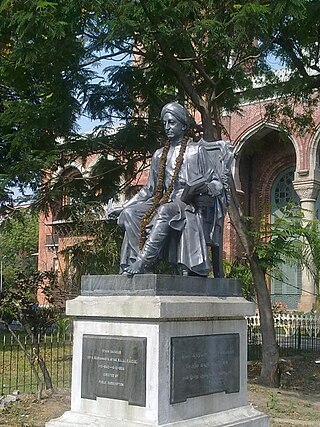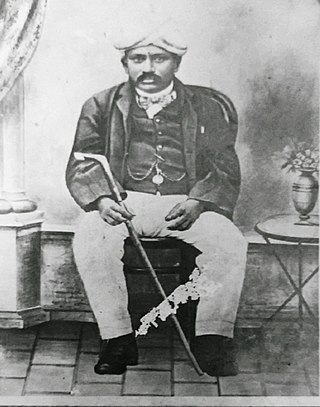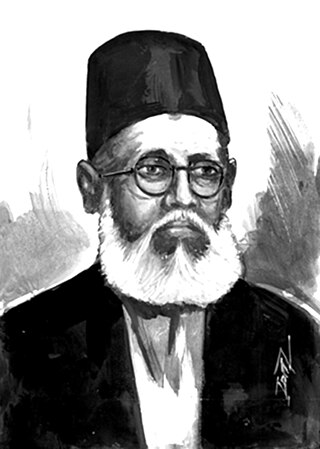
Semmangudi Radhakrishna Srinivasa Iyer was an Indian Carnatic vocalist. He was the youngest recipient of the Sangeetha Kalanidhi awarded by the Music Academy in 1947, a distinction he holds to this day as of 2023, probably the only musician to receive that honour before reaching 40. He had received many other awards as well, including Padma Bhushan and Padma Vibhushan from the Government of India, Rajyasevanirata title from Travancore's erstwhile ruling family, Sangeet Natak Academy award (1953), Isai Perarignar from Government of Tamil Nadu and Kalidas Samman from Government of Madhya Pradesh. He was affectionately addressed as "Semmangudi Maama" by his disciples. He was also considered the "Pitamaha" or the grand sire of modern Carnatic Music. He was conferred with an honorary doctorate by University of Kerala in 1979.

Uttamadhanapuram Venkatasubbaiyer Swaminatha Iyer was a Tamil scholar and researcher who was instrumental in bringing many long-forgotten works of classical Tamil literature to light. His singular efforts over five decades brought to light major literary works in Tamil and contributed vastly to the enrichment of its literary heritage. Iyer published over 90 books in his lifetime, on a variety of matters connected to classical Tamil literature, and collected over 3,000 paper manuscripts, palm-leaf manuscripts and notes of various kinds.

Cirupitty Wyravanathar Thamotharampillai (Pillai) ), sometimes referred to by the initials as C. Y., devoted his energies to the work of editing and publishing some of the oldest works of classical Tamil poetry and grammar. According to Kamil Zvelebil, he was the first person to be "engaged in the rediscovery of the earliest classical literature" of Tamil, and that his "greatness and merits have never been acknowledged".

Thanjavur Marathi people, are a Thanjavur Marathi-speaking ethno-linguistic group, who reside in the central and northern parts of the Indian state of Tamil Nadu. They are the descendants of Marathi administrators, soldiers and noblemen who migrated to this region during the rule of the Thanjavur Maratha kingdom. Thanjavur was a Maratha kingdom in Tamil Country, until the British East India Company dethroned the last Thanjavur Maratha king, Shivaji of Thanjavur. It was founded by Maratha Warrior King Chatrapati Shivaji's half-brother, Ekoji alias Venkoji Rajē Bhonsalē. The Kshatriyas use Maratha, while the Brahmins use the surname Deshastha.

Sir Pazhamaneri Sundaram Sivaswami Iyer was a prominent lawyer, administrator and statesman who served as the Advocate General of Madras from 1907 to 1911.

Ganapathy Dikshitar Subramania Iyer was a leading Indian journalist, social reformer and freedom fighter who led the Triplicane Six in launching The Hindu, an English newspaper on 20 September 1878. He was proprietor, editor and managing director of The Hindu from 20 September 1878 to October 1898. The Tamil language newspaper 'Swadesamitran' was also founded by him in 1891.

Sir Subbier Subramania Iyer was an Indian lawyer, jurist and freedom fighter who, along with Annie Besant, founded the Home Rule Movement. He was popularly known as the "Grand Old Man of South India".
Taxation of salt has occurred in India since the earliest times. However, this tax was greatly increased when the British East India Company began to establish its rule over provinces in India. In 1835, special taxes were imposed on Indian salt to facilitate its import. This paid huge dividends for the traders of the British East India Company. When the Crown took over the administration of India from the Company in 1858, the taxes were not replaced.
S. A. Kumari Durga was a musicologist and ethnomusicologist from the Indian state of Tamil Nadu. She was the founder of the Centre for Ethnomusicology based in Chennai.
Diwan Bahadur Rishiyur Venkata Srinivasa Aiyar was an Indian civil servant, legislator and politician from the Madras Presidency.

C. Jambulingam MudaliarCIE was an Indian politician and freedom-fighter who served as a civil court judge and member of the Madras Legislative Council. He was one of the foremost leaders of the Indian National Congress in the 1890s.

P. Dawood Shah was a Tamil enthusiast and scholar, Activist and a gold medalist from Madurai Tamil Sangam. He also known as "Kamba Ramayana Sahib".
K. Kalyanasundaramier was a leading advocate, philanthropist and Indian politician from Tanjore who served as a member of the Madras Legislative Council from the Municipalities seat from 1892 to 1897.

Thanjavur District was one of the districts in the erstwhile Madras Presidency of British India. It covered the area of the present-day districts of Thanjavur, Tiruvarur, Nagapattinam, Mayiladuthurai and Aranthangi taluk, Karambakkudi taluk of Pudukkottai District in Tamil Nadu. Apart from being a bedrock of Hindu orthodoxy, Tanjore was a centre of Chola cultural heritage and one of the richest and most prosperous districts in Madras Presidency.
The Indian independence movement had a long history in the Tamil-speaking districts of the then Madras Presidency going back to the 18th century.

Sir Thyagaraja Sadasiva Iyer was an Indian judge and theosophist who served as the Chief Justice of Travancore from 1905 to 1910. He was also the first President of the Hindu Religious and Charitable Endowments Department, Madras Presidency.

The Vedaranyam March was a framework of the nonviolent civil disobedience movement in British India. Modeled on the lines of Dandi March, which was led by Mahatma Gandhi on the western coast of India the month before, it was organised to protest the salt tax imposed by the British Raj in the colonial India.

The Mylapore Clique or oligarchy was a small coterie, amounting to a "handful" of politically moderate, elite Brahmins, primarily Tamil Brahmins, many of them noted lawyers, administrators, academics or educators, or industrialists, in the Madras Presidency, who 'wielded almost exclusive influence and patronage in the service and government appointments', 'controlled the flow of resources out of the institutions of the capital' and 'dominated the professional and political life of [the presidency].' Informal and exclusive, it was historically controlled by two extended families, the Vembaukum Iyengars, and the Calamur Viravalli-Chetpet Iyers, and took its name from the luxurious Madras City neighborhood in which many leading members kept mansions. The clique coalesced and began its dominance in the 1880s and 1890s under the headship of Sir V. Bhashyam Aiyangar and Sir S. Subramania Iyer, with R. Raghunatha Rao as a tertiary leader; while some argue that it reached its zenith between 1910 and 1920, others highlight its remarkable successes in ministry and magistracy continuing in the 1920s and 1930s, with Sir C. P. Ramaswami Iyer as leader.













